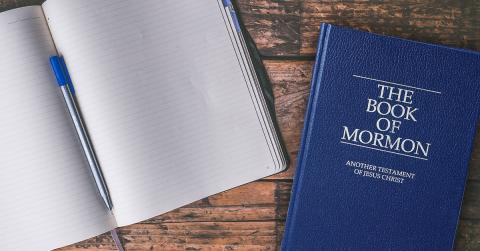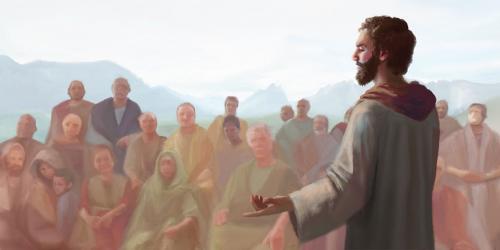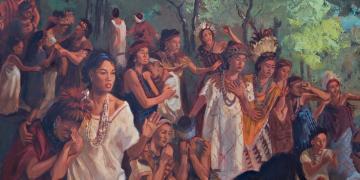You are here
Book of Mormon Central is in the process of migrating to our new Scripture Central website.
We ask for your patience during this transition. Over the coming weeks, all pages of bookofmormoncentral.org will be redirected to their corresponding page on scripturecentral.org, resulting in minimal disruption.

Scripture Block
Jacob 1–4
March 9–15. Be Reconciled unto God through the Atonement of Christ
KnoWhys
Recommended Resources
Learn about the Book of Mormon with verse by verse commentaries from renowned Book of Mormon scholars like John W. Welch and Brant A. Gardner in the ScripturePlus app. Read this week's KnoWhy connected with the Come Follow Me curriculum, and watch a video elucidating an insight in this week's scripture reading.
Reading Plan
Structure your personal scripture study by following a multimedia, day by day plan. Each day's assignment includes the required scripture passages from the Come Follow Me curriculum, as well as suggestions for additional resources to bring context and understanding to your study. To dive deeper, skip down to Additional Resources for a selected bibliography on this week's chapters. If you are looking to dive deep into your study, skip down to "Additional Resources" for a selected bibliography of articles, books, and chapters on Jacob 1–4.
Monday
- Jacob 1:1–19
- KnoWhy 62: Why Does Jacob Quote So Much from the Psalms?
- KnoWhy 319: Why Did Lehi Divide His People into Seven Tribes?
- Chart: The Seven Tribes of Lehi
Tuesday
- Jacob 2:1–11
- Quote: “There are countless examples of priesthood holders who shouldered that grave responsibility as you and I must. This is how Jacob in the Book of Mormon described his sacred trust when he moved in difficult circumstances to give aid . . . Now, you might object that Jacob was a prophet and you are not. But your office, whatever it is in the priesthood, brings with it an obligation to 'lift up the hands which hang down, and strengthen the feeble knees' of those around you. You are the Lord’s servant covenanted to do for others, as best you can, what He would do.” Eyring, Henry B. “Man Down!”, General Conference April 2009.
- Quote: “The poet-prophet Jacob witnessed among Church members how covenant-breaking wounded “delicate minds” and how hearts were “pierced with deep wounds.” He was “weighed down” and so heavy with sorrow because some members esteemed their covenants so lightly. As I witness some of today’s walking wounded, I understand Jacob’s feelings as never before!” Maxwell, Neal A. “Overcome… Even As I Also Overcame,” General Conference April 1987.
- Quote: “The invitation to repent is an expression of love…. If we do not invite others to change or if we do not demand repentance of ourselves, we fail in a fundamental duty we owe to one another and to ourselves. A permissive parent, an indulgent friend, a fearful Church leader are in reality more concerned about themselves than the welfare and happiness of those they could help. Yes, the call to repentance is at times regarded as intolerant or offensive and may even be resented, but guided by the Spirit, it is in reality an act of genuine caring.” Christofferson, D. Todd, “The Divine Gift of Repentance,” General Conference October 2011.
Wednesday
- Jacob 2:12–21
- KnoWhy 518: Why Does the Book of Mormon Warn Against Seeking after Riches?
- Quote: “Wealth is a jealous master who will not be served halfheartedly and will suffer no rival—not even God … Wealth promises security, power, position, and honors, in fact anything in this world. Above all, the Nephites, like the Romans saw in it a mark of superiority and would do anything to get hold of it, for to them 'money answereth all things'… The more important wealth is, the less important it is how one gets it.” Nibley, Hugh. Since Cumorah. 393. Edited by John W. Welch. Salt Lake City, UT: Deseret Book Co., 1988.
Thursday
- Jacob 2:22–35
- KnoWhy 64: What Does the Book of Mormon Say About Polygamy?
- Quote: “Had plurality of wives been sinful in man, the inference is reasonable that it would have been equally condemned. Although plural marriage was customary in the days of the patriarchs, some assert that it was done away in Christ. This would seem very inconsistent when he himself was of a polygamous lineage. He was born and filled his earthly mission among a polygamous people, yet, he never reproved them for their plural marriages. There is nothing in the inspired writings to infer that he reproved or did away with either polygamy or monogamy.” Richards, Franklin D., and James A. Little. Compendium of the Doctrines of the Gospel. 124–132. George Q. Cannon and Sons, 1892.
Friday
Explore Further
- KnoWhy 57: What Does it Mean to be a White and Delightsome People?
- KnoWhy 435: Did “Others” Influence Book of Mormon Peoples?
Saturday
- Jacob 4:1–4
- KnoWhy 512: Is the Book of Mormon Like Other Ancient Metal Documents?
- KnoWhy 65: Why Did Jacob Call his Record the "Plates of Jacob"?
Explore Further
Sunday
- Jacob 4:5–18
- Quote: “Other great prophets of the Book of Mormon—in their own way and time—testified of the divinity of the Lord Jesus Christ. Among them were the brother of Jared, Zenock, Neum, and Zenos. Testimonies of Jesus Christ that predated His birth in Bethlehem were also recorded from King Benjamin, Abinadi, Alma the Elder, Alma the Younger, Amulek, the sons of Mosiah, Captain Moroni, the brothers Nephi and Lehi, and Samuel the Lamanite. In a seemingly endless sequence of prophetic proclamations—testimonies of “all the holy prophets” for “a great many thousand years before his coming”—the Book of Mormon makes the solemn declaration that Jesus is the Christ, our Savior and Redeemer.” Nelson, Russell M. “A Testimony of the Book of Mormon,” General Conference October 1999.
- Quote: “Whenever the Lord revealed Himself to men in ancient days, and commanded them to offer sacrifice to Him, that it was done that they might look forward in faith to the time of His coming, and rely upon the power of that atonement for a remission of their sins. On this matter the Book of Mormon prophets are quite plain and none plainer than Jacob…” McConkie, Joseph Fielding. “The Testimony of Christ Through the Ages.” Essay. In The Book of Mormon: Jacob through Words of Mormon, to Learn with Joy, edited by Monte S. Nyman and Charles D. Tate, 162. Provo, UT: Religious Studies Center, Brigham Young University, 1990.
- KnoWhy 412: How Abraham’s Sacrifice of Isaac Illuminates the Atonement
Additional Resources (Bibliography)
Jacob Overview
Tanner, John S. “Jacob and His Descendants as Authors.” In Rediscovering the Book of Mormon: Insights that You May Have Missed Before. Edited by John L. Sorenson and Melvin J. Thorne. Salt Lake City, UT: Deseret Book and FARMS, 1991.
Welch, John W., and Greg Welch. Who Kept the Records in the Book of Mormon? (Overview). Provo, UT: Foundation for Ancient Research and Mormon Studies, 1999.
Jacob 1
Halverson, Taylor. "Jacob 1-4. Seek the Kingdom of God." Interpreter Resources for Students and Teachers. March 5, 2016.
Bokovoy, David E.. Holiness to the Lord: Biblical Temple Imagery in the Sermons of Jacob the Priest. The Interpreter Foundation, 2012.
Larsen, Val. "A Mormon Theodicy: Jacob and the Problem of Evil." Interpreter: A Journal of Mormon Scripture 15 (2015): 239-266.
Jacob 1:10
Bowen, Matthew L.. "Jacob's Protector." Interpreter: A Journal of Mormon Scripture 27 (2017): 229-256.
Jacob 1:17
Book of Mormon Central. “Why Does Jacob Quote So Much from the Psalms? (Jacob 1:7).” KnoWhy 62 (March 25, 2016).
Book of Mormon Central. “Why New Testament Words and Phrases Are in the Book of Mormon Part 5: How Often Were Scriptures on the Plates of Brass the Common Source? (Jacob 1:7).” KnoWhy 533 (September 26, 2019).
Hilton, III, John. "Old Testament Psalms in the Book of Mormon." In Ascending the Mountain of the Lord: Temple, Praise, and Worship in the Old Testament (2013 Sperry Symposium), 291-311. Salt Lake City: Deseret Book, 2013.
Jacob 1:13
Book of Mormon Central. “Why Did Lehi Divide His People into Seven Tribes? (Jacob 1:13).” KnoWhy 319 (May 29, 2017).
Sorenson, John L., John A. Tvedtnes, and John W. Welch. "Seven Tribes: An Aspect of Lehi's Legacy." In Reexploring the Book of Mormon, edited by John W. Welch, 93-95. Provo, UT/Salt Lake City: FARMS/Deseret Book, 1992.
Jacob 2
Jacob 2:9; 2:35; 3:1; 4:14
Lindsay, Jeff. “The Possibility of Janus Parallelism in the Book of Mormon.” Interpreter: A Journal of Latter-day Saint Faith and Scholarship 28 (2018): 1–20.
Jacob 2:12–18
Book of Mormon Central. “Why Does the Book of Mormon Warn Against Seeking after Riches? (Jacob 2:18).” KnoWhy 518 (May 30, 2019).
Perry, L. Tom. “United in Building the Kingdom of God” In The One Hundred and Fifty-Seventh Annual General Conference of the Church of Jesus Christ of Latter-day Saints. Salt Lake City: The Church of Jesus Christ of Latter-day Saints, 1987.
Robson, R. Thayne. Wealth, Attitudes Toward In Encyclopedia of Mormonism, Edited by Daniel H. Ludlow. Vol. 4. New York: Macmillan, 1992.
Tvedtnes, John A.. "Promiscuity and the Search for Wealth." In The Most Correct Book: Insights from a Book of Mormon Scholar, 161-166. Salt Lake City: Cornerstone Publishing, 1999.
Jacob 2:24–30
Baird, Brian J.. "Understanding Jacob’s Teachings about Plural Marriage from a Law of Moses Context." Interpreter: A Journal of Mormon Scripture 25 (2017): 227-237.
Book of Mormon Central. “What Does the Book of Mormon Say About Polygamy? (Jacob 2:30.” KnoWhy 64 (Marcy 28, 2016).
Welch, John W., and Greg Welch. Women in the Book of Mormon. Provo, UT: Foundation for Ancient Research and Mormon Studies, 1999.
Jacob 2:27–33
Stamps, Wm. Lyle. “Divine Speech Texts in the Book of Mormon.” Insights: A Window on the Ancient World 20, no. 4 (2000): 2.
Jacob 3
Jacob 3:7
Book of Mormon Central. “How Can the Book of Mormon Strengthen Marriages and Families? (Jacob 3:7).” KnoWhy 302 (April 19, 2017).
Jacob 3:13
Book of Mormon Central. “Did “Others” Influence Book of Mormon Peoples? (Jacob 3:13).” KnoWhy 435 (May 22, 2018).
Jacob 3:14
Book of Mormon Central. “Why Did Jacob Call his Record the "Plates of Jacob"? (Jacob 3:14).” KnoWhy 65 (March 29, 2016).
Jacob 4
Skousen, Royal. "Jacob 4–6: Substantive Textual Variants between Manuscripts and Editions." In The Allegory of the Olive Tree: The Olive, the Bible, and Jacob 5, edited by Stephen D. Ricks and John W. Welch, 105-139. Provo, UT/Salt Lake City: Foundation for Ancient Research and Mormon Studies/Deseret Book, 1994.
Jacob 4:2
Book of Mormon Central. “Is the Book of Mormon Like Other Ancient Metal Documents? (Jacob 4:2).” KnoWhy 512 (April 25, 2019).
Jacob 4:4
Book of Mormon Central. “What Can Stylometry Tell Us about Book of Mormon Authorship? (Jacob 4:4).” KnoWhy 389 (December 12, 2017).
Jacob 4:5
Book of Mormon Central. “How Abraham’s Sacrifice of Isaac Illuminates the Atonement (Jacob 4:5).” KnoWhy 412 (March 1, 2018).
Jacob 4:8
Call, Gail. "Antenantiosis in the Book of Mormon." In Reexploring the Book of Mormon, edited by John W. Welch, 96-97. Provo, UT/Salt Lake City: FARMS/Deseret Book, 1992.
Bassett, W. Mark. For Our Spiritual Development and Learning In The One-Hundredth and Eighty-Sixth Semiannual General Conference of the Church of Jesus Christ of Latter-day Saints. Salt Lake City: The Church of Jesus Christ of Latter-day Saints, 2016.
Jacob 4:11–12
Thompson, A. Keith. "The Doctrine of Resurrection in the Book of Mormon ." Interpreter: A Journal of Mormon Scripture 16 (2015): 101-129.
Tvedtnes, John A. “Atonement and the Temple.” Insights: A Window on the Ancient World 25, no. 6 (2005): 5.
Jacob 4:14
Christensen, Kevin. “Jacob’s Connections to the First Temple Traditions.” Insights: A Window on the Ancient World 23, no. 4 (2003): 2–3.
Hoskisson, Paul Y. “Missing the Mark.” Insights: A Window on the Ancient World 29, no. 2 (2009): 2–3.
Jacob 4:15–16
Book of Mormon Central. “Why New Testament Words and Phrases Are in the Book of Mormon Part 6: Why Do Similar Clusters of Old Testament Texts Appear in Both? (Jacob 4:15–16).” KnoWhy 535 (October 10, 2019).
Jacob 4:17
Book of Mormon Central. “Why Did Jacob Share the Allegory of the Olive Tree? (Jacob 4:17).” KnoWhy 66 (March 30, 2016).




